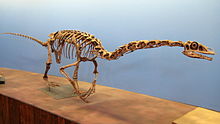| Falcarius Temporal range: Early Cretaceous,
~ | |
|---|---|

| |
| Reconstructed skeleton, Natural History Museum of Utah | |
| Scientific classification | |
| Domain: | Eukaryota |
| Kingdom: | Animalia |
| Phylum: | Chordata |
| Clade: | Dinosauria |
| Clade: | Saurischia |
| Clade: | Theropoda |
| Clade: | Maniraptora |
| Clade: | †Therizinosauria |
| Genus: | †Falcarius Kirkland et al. 2005 |
| Type species | |
| †Falcarius utahensis Kirkland et al. 2005
| |
Falcarius (meaning "sickle cutter") is a genus of primitive therizinosaur dinosaur that lived during the Early Cretaceous period in what is now North America. Its remains were first collected in the Cedar Mountain Formation in 1999, with subsequent findings made during the 2000s. The genus is known from multiple specimens ranging from immature to fully-grown individuals.
Falcarius was a 4 m (13 ft) long bipedal herbivore with a small head and an elongated neck and tail. Unlike advanced therizinosaurs, Falcarius had a propubic pelvis and three-toed feet with a reduced hallux (first digit).
Falcarius is the basal most known definitive therizinosaurian genus, and has been considered a transitional form connecting the typical theropod bodyplan to the unusual morphology of Therizinosauridae. Its description in 2005, following that of the basal therizinosauroid Beipiaosaurus from the Early Cretaceous of China in 1999, helped clarify the early evolution of the Therizinosauria and its relationships within the larger group of Theropoda.
- ^ Joeckel, R. M.; Ludvigson, G. A.; Möller, A.; Hotton, C. L.; Suarez, M. B.; Suarez, C. A.; Sames, B.; Kirkland, J. I.; Hendrix, B. (2020). "Chronostratigraphy and terrestrial palaeoclimatology of Berriasian–Hauterivian strata of the Cedar Mountain Formation, Utah, USA". Geological Society, London, Special Publications. 498 (1): 75–100. Bibcode:2020GSLSP.498...75J. doi:10.1144/SP498-2018-133. S2CID 210296827.